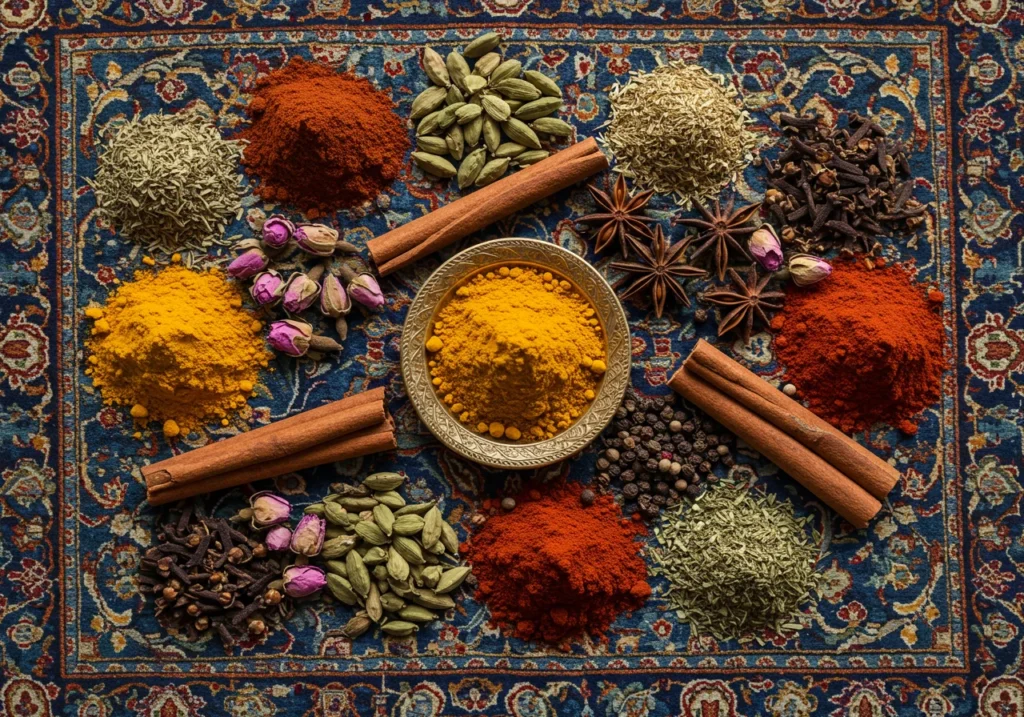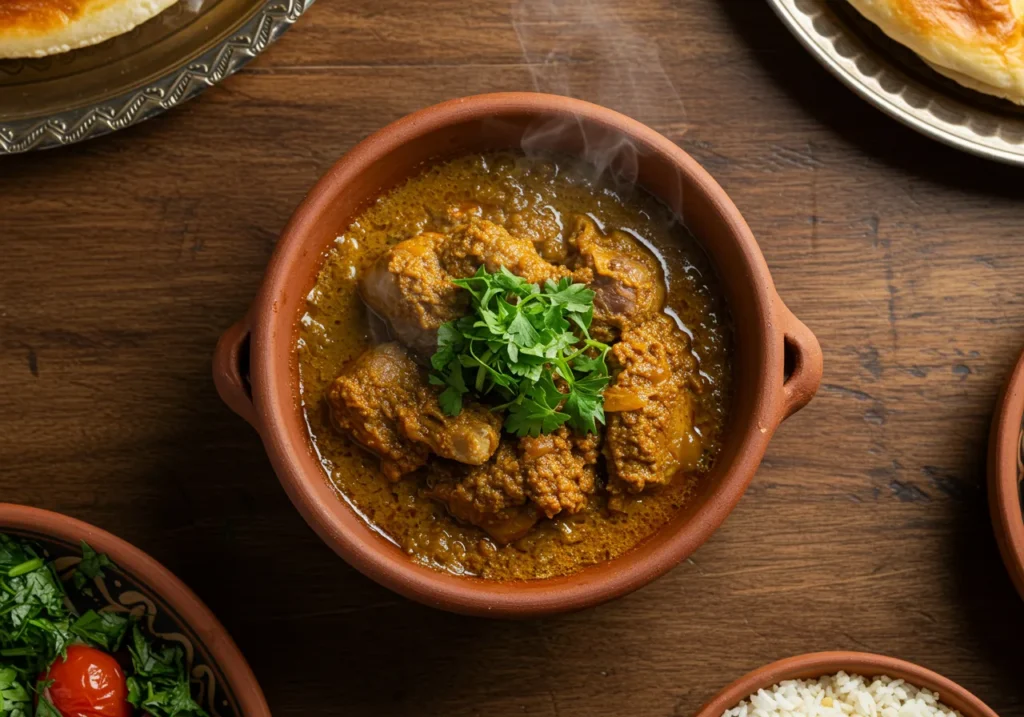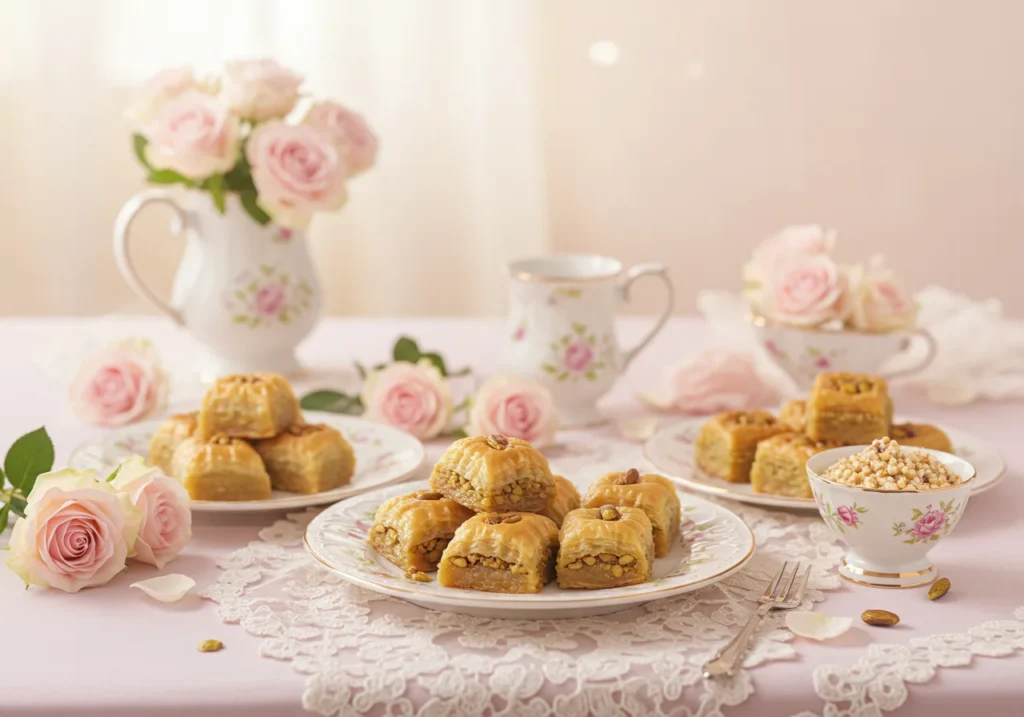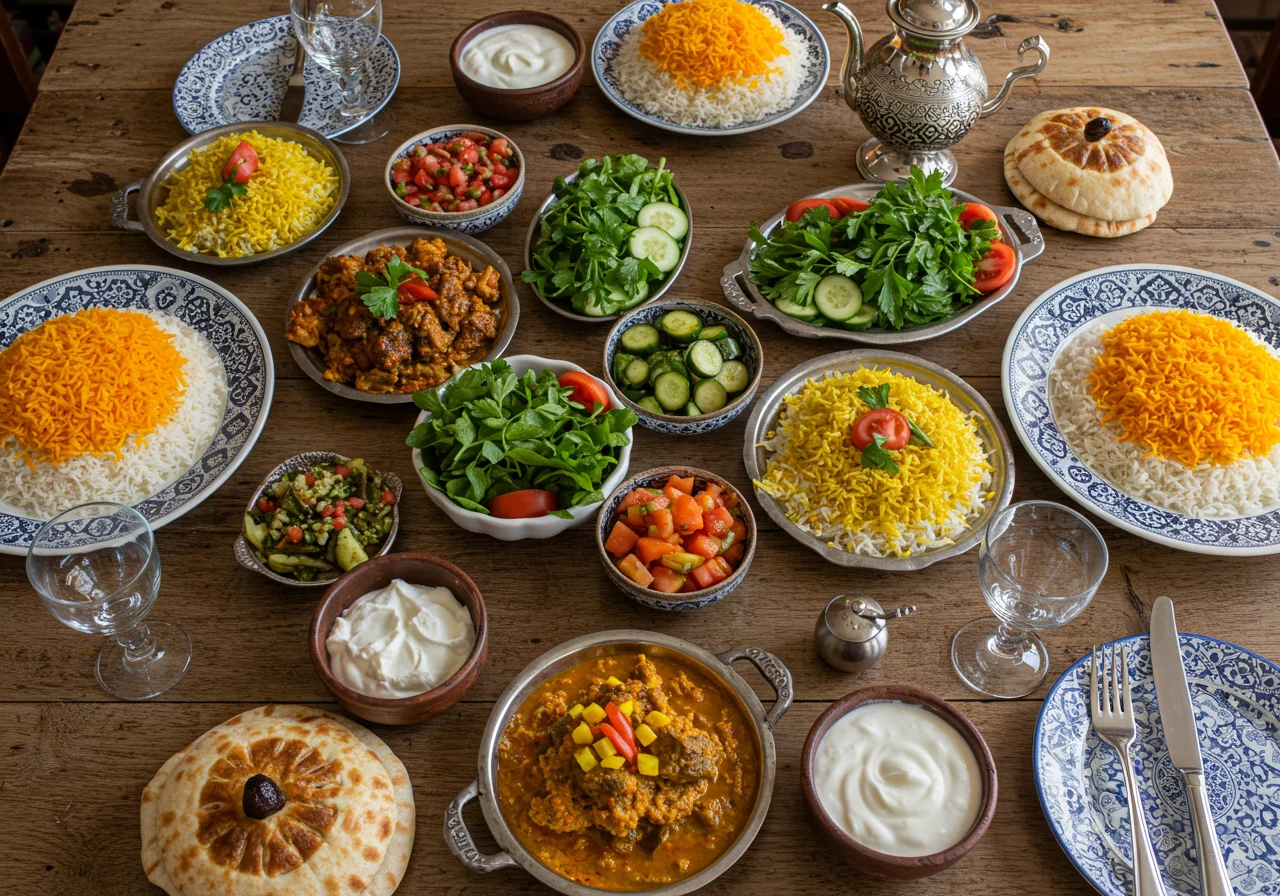Introduction
Persian cuisine isn’t just about food—it’s a vivid celebration of culture, history, and tradition on a plate. From steamed saffron rice with a golden crust to rich herb-packed stews, every Persian recipe tells a flavorful story passed down through generations. In this guide, you’ll discover the roots and rituals of Persian cooking, explore iconic dishes, learn essential ingredients and techniques, and even get a taste of my own experience trying one of these masterpieces. By the end of this article, you’ll not only understand Persian food better, but you’ll also feel ready to bring it into your own kitchen.
So, let’s dive into the first chapter of this culinary journey—understanding the roots that make Persian cuisine so irresistibly unique.
Part 1: Introduction to Persian Cuisine
The Heart and Soul of a Persian Recipe
Persian cuisine, also known as Iranian cuisine, is a vibrant fusion of flavors, aromas, and textures deeply rooted in ancient history. It’s not just about the meal—it’s about hospitality, gathering, and heritage. For Iranians, food brings people together, often around a beautifully set table called a sofreh. This cultural ritual transforms meals into meaningful memories.
If you’ve ever tasted a Persian recipe, you’ve likely been enchanted by the layers of herbs, the aromatic saffron, the harmony of sweet and sour, and the care that goes into every bite. Whether it’s a casual family dinner or a grand Nowruz feast, Persian food plays a key role in both daily life and cherished celebrations.
What Sets Persian Recipes Apart
While it may share similarities with Mediterranean and other Middle Eastern cuisines, Persian cooking dances to its own tune. It’s subtle and refined. Instead of overpowering heat, it leans into delicate spices, like turmeric and cinnamon, alongside bright punches of lime and sumac. Fresh herbs—mint, parsley, dill, and cilantro—appear in abundance, while rice, legumes, and yogurt-based dishes form the comforting base of many meals.
Oh, and don’t even get me started on the saffron—liquid gold that perfumes everything from stews to ice cream.
The Role of Persian Recipes Around the World
Thanks to global diaspora communities, Persian food has reached kitchens and restaurants across the world. But even so, it often remains underrepresented in mainstream culinary discussions. That’s why this guide exists—not only to celebrate its depth but to invite you to explore it for yourself.
When I cooked my very first Persian recipe, I didn’t expect the explosion of fragrance when I toasted turmeric in oil or the mesmerizing transformation of plain rice into golden-crusted tahdig. It felt like a culinary rite of passage. Trust me—you’re going to want to try this.
Global Influences on Persian Cuisine
Historically positioned on the Silk Road, Iran absorbed influences from India, China, Turkey, and even Europe. Yet, its cuisine maintained its own core identity. That’s why you’ll find dishes like Khoresht Fesenjan (walnut and pomegranate stew) that feel wholly Persian, despite incorporating ingredients like nuts and fruit that arrived through ancient trade.
And here’s the real magic—while Persian food respects centuries of tradition, it also adapts beautifully. Modern Persian kitchens may serve vegan versions of classic stews, or add a Western twist to old-school rice dishes. That’s the sign of a living, breathing cuisine.
Part 2: Historical and Cultural Context
The Rich History of Persian Cuisine
If food is a window into culture, then Persian recipes are a stained glass masterpiece—colorful, layered, and timeless. Dating back thousands of years to the ancient Persian Empire (think Achaemenids and Sassanids), Iran’s culinary history is as rich as its poetry. From the golden palaces of Persepolis to the bustling bazaars of Isfahan, every era contributed something unique to Persian cuisine.
Originally, early Persian meals revolved around simple staples: wheat, dates, and yogurt. Yet as dynasties rose and fell, each brought with them new techniques and ingredients. The introduction of rice, for instance, wasn’t native—it came from the East and gradually transformed into dishes like chelow and sabzi polo. Saffron, now an iconic Persian ingredient, likely became prominent during the Islamic Golden Age, when trade and science flourished in the region.
And get this—I once tried a version of khoresh based on a centuries-old recipe from Shiraz. Even with a modern twist, it felt like tasting history itself. That’s how timeless these flavors are.
Evolution Through Ancient Civilizations
Ancient civilizations such as the Elamites and Parthians laid the groundwork for what would evolve into modern Iranian cooking. Techniques like stewing meat in earthenware pots or seasoning with dried herbs were passed down like sacred rites. The Persians were early adopters of refrigeration too—thanks to the yakhchal, a type of ancient cooler made of desert ice and insulation.
Influence of Trade Routes on Persian Culinary Practices
Iran’s central position along the Silk Road was a flavor jackpot. Traders and travelers brought exotic goods like Chinese noodles, Indian spices, and even citrus from the Arabian Peninsula. In return, Persia shared its saffron, pomegranates, pistachios, and even its culinary philosophy—where food was not only for sustenance but a reflection of love and hospitality.
This East-meets-West fusion helped elevate the complexity of Persian food. It’s why you might find rosewater in both sweets and stews, or why dried fruits often appear next to savory meats. Persian cuisine isn’t afraid of contradiction—it embraces it like a long-lost friend.
Cultural Significance of Persian Recipes
Food in Persian culture isn’t just something you eat—it’s how you connect. Whether you’re celebrating Nowruz, mourning a loved one, or simply catching up with friends, food is at the center. Recipes are handed down not through cookbooks, but from one generation to another, often from mother to daughter. Or as the saying goes in every Persian household: “I got it from my maman.”
Even when I attempted my first Persian recipe, I felt that legacy. The precision. The care. The gentle reminder that food is love.
Role of Food in Persian Festivals and Daily Life
During Nowruz, the Persian New Year, you’ll find symbolic foods like sabzi polo (herb rice), mahi (fish), and reshteh polo (noodle rice), each meant to bring prosperity. Likewise, Yalda Night, the longest night of the year, is marked with pomegranates, watermelon, and poetry.
Yet, it’s not only the grand occasions. Everyday meals carry meaning too. A simple bowl of ash reshteh after a long day is comfort in its purest form. Even bread—from lavash to sangak—is revered, never wasted, and often shared with a blessing.
Traditional Dining Customs and Etiquette
Persian hospitality is legendary. Guests are treated like royalty, and there’s always “just a little more” food no matter how full you are. Meals are typically served family-style, and elders are always invited to eat first. Oh, and never skip the tea—it closes the meal, soothes the soul, and often sparks the best conversations.
Dining often happens on the floor, with a sofreh (cloth) laid out, surrounded by loved ones. It’s humble, cozy, and deeply personal. This communal style reinforces the value of unity and respect—core tenets of Iranian culture.
Part 3: Essential Ingredients and Techniques
Staple Ingredients in Persian Cooking
So, you’ve decided to venture into the magical world of Persian recipes—fantastic choice! But before you roll up your sleeves, you’ve gotta stock that pantry like a pro. Persian cuisine relies on a unique combination of aromatic herbs, tangy flavors, and rich textures that are unmistakably its own. Let’s open the door to what gives Persian food its unforgettable taste.
Common Herbs, Spices, and Other Essential Components
Start with the holy trio: turmeric, saffron, and dried limes. These flavor powerhouses form the backbone of countless Persian dishes. Turmeric lends warmth, saffron adds that golden hue and subtle floral note, and dried limes (limoo amani) deliver a sour punch that’s totally addictive.

Then you’ve got the herbs—parsley, cilantro, mint, dill, and fenugreek—used either fresh or dried. These aren’t just garnishes. Nope. They’re key players, often used in generous amounts to layer flavor and aroma, especially in stews like ghormeh sabzi.
And let’s not forget pomegranate molasses, rosewater, sumac, barberries (zereshk), yogurt, and rice—lots of it. Basmati is typically the go-to for its long, elegant grains and fluffy finish.
Oh, and when you try cooking with zereshk for the first time, you’ll notice the tang is balanced out by butter. Persian food always plays with balance—sour and sweet, herbaceous and earthy.
Importance of Fresh and Dried Herbs in Flavor Profiles
Persian cooks use herbs like they mean it. In fact, you’ll often see them chopped into stews by the cupful. Fresh herbs bring brightness, while dried versions deepen the flavor. Think of it like music: fresh herbs are the melody; dried ones are the harmony.
Dishes like ash reshteh (herb noodle soup) or kuku sabzi (herb frittata) don’t just contain herbs—they are herbs with a few bonus ingredients. Seriously, it’s no joke. I once made kuku sabzi using a mix of fresh parsley, chives, and dill—let’s just say it was more green than egg, and it was divine.
Traditional Cooking Techniques
If the ingredients are the soul of a Persian recipe, then the techniques are its heartbeat. Cooking Persian food isn’t just about following steps—it’s about patience, precision, and passion. You don’t rush a masterpiece, right?
Methods such as Slow-Cooking Stews and Rice Steaming
Slow-cooking is practically a religion in Iranian kitchens. Stews, or khoresh, simmer for hours until meat becomes melt-in-your-mouth tender and the flavors marry like a dream. The longer it cooks, the better it tastes. That’s why you’ll often see Persian families starting dinner prep early in the morning.
Another legendary technique? The Persian rice method. It involves soaking, parboiling, and then steaming the rice to fluffy perfection. The result? Each grain stands tall—never sticky, never clumpy. And the crown jewel? That crispy bottom layer known as tahdig.
Use of Specific Cookware Like the “Tahdig” Pot
Creating that golden crust requires serious skill—and the right tools. Traditionally, Persian cooks use a non-stick or heavy-bottomed pot. Some even place lavash bread or thinly sliced potatoes at the bottom for an extra layer of texture and taste.
A good damkoni (fabric rice cover) helps trap steam while keeping the top layer airy. I used a clean kitchen towel the first time (totally works), and the results were so satisfying, I may have snapped a pic before letting anyone dig in.
Want to dive deeper into cookware techniques? Check out this insightful breakdown on Saffron & Herbs—a great source for Persian culinary secrets.
Part 4: Iconic Persian recipe
Persian Rice Dishes
Let’s be real—Persian rice is in a league of its own. It’s not just a side dish; it’s an event. Light, fluffy, and fragrant, it forms the heart of many Persian meals. The real charm? Each dish brings something unique to the table—literally.

Chelow (Steamed Persian recipe Rice)
Chelow is the quintessential Iranian rice. Imagine perfectly steamed, buttery grains of basmati rice, each one separate and glistening. To get there, you’ve gotta rinse the rice thoroughly, soak it in salted water, parboil it, and finally steam it with a touch of oil or butter.
Why all the effort? Because chelow is meant to be the ideal neutral base to balance out the bold flavors of rich khoreshes (Persian stews). It’s often served with kababs or stew and is a must during formal meals and festive gatherings. When I nailed it the first time, I practically called my whole family over to admire the grains standing like proud little soldiers.
Tahdig (Crispy Rice Crust)
Ah, tahdig—the golden, crispy crown jewel at the bottom of every Persian rice pot. Whether made with plain rice, lavash bread, or potato slices, this crunchy delight is the most fought-over part of the meal.
To get the perfect tahdig, the trick is a low and slow steam phase. A non-stick or heavy-bottomed pot is key, and once you flip that pot and reveal the crispy layer, it’s nothing short of applause-worthy. Some sprinkle saffron water before steaming for that irresistible color and aroma.
Sabzi Polo (Herb Rice)
Sabzi polo is chelow’s aromatic cousin, infused with a garden’s worth of chopped herbs—typically parsley, cilantro, dill, and sometimes fenugreek. Served most famously with white fish for Nowruz (Persian New Year), it symbolizes rebirth and freshness.
I cooked sabzi polo last spring, and the house smelled like springtime joy. Each bite was herbaceous, light, and full of promise—a celebration on a plate.
📌 Want a visual step-by-step? Visit The Spice Spoon for personal and flavorful insights into Persian rice dishes.

Hearty Persian recipe Stews
In Persian cuisine, stews—or khoresh—are slow-cooked marvels that sing with flavor. Each one has its own identity and ingredient soulmates, but they all share a common trait: depth of flavor that hugs you from the inside.
Ghormeh Sabzi (Herb Stew)
Revered as Iran’s unofficial national dish, ghormeh sabzi is a vibrant stew made with sautéed herbs (parsley, cilantro, fenugreek), kidney beans, dried limes, and tender chunks of lamb or beef. It simmers slowly until it becomes a thick, green wonder.
Each family adds their own twist—more fenugreek, different beans—but the essence remains unchanged. The stew is sour, rich, and beautifully complex. It’s one of those dishes that tastes even better the next day.
Fesenjan (Pomegranate and Walnut Stew)
If ghormeh sabzi is earthy, then fesenjan is decadent. This deep brown stew combines ground walnuts with tangy pomegranate molasses, usually cooked with chicken or duck.
Its flavor is a luxurious balance of sweet and sour—rich, nutty, and unmistakably Persian. Some families sweeten it more, others prefer it tart. When I made it, I leaned tart—served it over chelow, and I swear the silence at the table said it all.
Gheimeh (Split Pea Stew)
Gheimeh is a comforting tomato-based stew that features yellow split peas, tender meat, and a zingy infusion of dried lime. Topped with crispy fried potato sticks, it’s like comfort food with flair.
You’ll often see it served during religious ceremonies, especially Ashura. While simple at first glance, the timing of each step—like when to add the limoo amani—is crucial. Skip it, and it’s just not gheimeh.
Popular Persian recipe Appetizers and Side Dishes
No Persian meal kicks off without a medley of vibrant appetizers and sides—refreshing, creamy, and herby delights that tease the palate and get you ready for the main event.
Mast-o-Khiar (Yogurt and Cucumber Dip)
Mast-o-khiar is cool, tangy, and loaded with diced cucumbers, dried mint, and sometimes crushed walnuts or raisins. Think of it as Iran’s version of tzatziki, only smoother and often enjoyed with lavash bread.
It’s perfect on a hot day, and I love serving it as a dip or a sauce next to kababs. You can even toss in fresh dill for an extra herbal punch.
Kashk-e Bademjan (Eggplant Dip)
This creamy appetizer stars eggplants that are grilled or fried, then mashed and mixed with onions, garlic, and kashk (fermented whey). It’s rich, tangy, and topped with crispy fried mint and golden onions.
Kashk isn’t easy to find everywhere, but some folks use thick yogurt as a substitute. Either way, it’s a silky, flavor-packed treat that disappears fast at parties.
Shirazi Salad
A crisp mix of cucumbers, tomatoes, and red onions finely chopped and tossed with lemon juice and dried mint, Shirazi salad is the Persian answer to a palate cleanser.
It’s refreshing, zesty, and always served cold. I usually prep it while the rice is steaming, and it’s the easiest win on any Persian menu.
Persian recipe Kebabs and Grilled Dishes
When it comes to Persian grilling, forget about dry skewers—these kebabs are juicy, flavorful, and downright addictive. You haven’t lived until you’ve tried kabab served over saffron rice with grilled tomato on the side.
Kabab Koobideh (Minced Meat Kebab)
Kabab koobideh is a finely ground mixture of lamb or beef (or both) blended with grated onions, salt, and pepper. It’s molded onto wide metal skewers and grilled over open flames for a smoky char.
The magic lies in the texture—tender, juicy, and oh-so-satisfying. Serve it with chelow, grilled tomato, sumac, and a pat of butter on top. Boom—perfection.
Joojeh Kabab (Grilled Chicken)
Joojeh kabab is marinated chicken (often bone-in) in a luxurious mix of yogurt, lemon juice, saffron, and onions. The result? Tender chicken with just the right balance of tang and depth.
Let it marinate overnight for best results. When I did, it absorbed the saffron like a sponge and grilled up juicy with that slight caramelized char—mmm.
Vegetarian Persian recipe
Although Persian food often features meat, there’s a whole garden of vegetarian options packed with flavor, protein, and nutrition.
Kuku Sabzi (Herb Frittata)
Kuku sabzi is like a Persian quiche—only greener, herbier, and without the crust. Made with eggs, chopped herbs, and sometimes walnuts or barberries, it’s fluffy on the inside and crisp on the outside.
Great warm or cold, it’s a Nowruz staple and also works beautifully for meal prep. The key? More herbs than eggs. Seriously.
Adas Polo (Lentil Rice)
Adas polo combines rice, lentils, raisins, and caramelized onions for a hearty, satisfying dish. Some versions include dates or nuts for a sweet-savory contrast.
It’s often made with lamb or ground beef, but just as comforting without. It’s filling, flavorful, and easy to make in batches—plus it smells like heaven while it’s cooking.
Part 5: Desserts and Beverages
Traditional Persian recipe Desserts
When it comes to sweets, Persian cuisine doesn’t hold back on charm. These aren’t your average desserts—oh no! They’re floral, exotic, and deeply tied to tradition. Persian sweets lean into ingredients like saffron, rosewater, and cardamom, offering not just a treat for the tongue but a poetic experience for all the senses.
Sholeh Zard (Saffron Rice Pudding)
Sholeh Zard is sunshine in a bowl. This golden saffron rice pudding is smooth, subtly sweet, and absolutely intoxicating in aroma. Made with rice, sugar, saffron, rosewater, and a sprinkle of cinnamon and slivered almonds on top, it’s both humble and heavenly.
Traditionally served during religious ceremonies and as an offering, it carries emotional significance for many Iranian families. The first time I made it, the scent alone transported me to an old Persian recipe courtyard—so aromatic, I couldn’t wait for it to cool.
Here’s a tip: let the pudding set for a few hours. That resting time allows the saffron to bloom fully, and the texture becomes even silkier. Also, the finishing touch—neatly drawn cinnamon patterns—turns it into edible art.

Bastani Sonnati (Persian Ice Cream)
If you’ve never had Bastani Sonnati, prepare for a taste revelation. This is Persian-style ice cream, and it’s nothing like the Western scoops you’re used to. Made with saffron, rosewater, pistachios, and often salep (orchid root powder), it’s stretchy, floral, and ultra-creamy.
This delicacy is often sandwiched between crispy wafer cookies or served alongside faloodeh (starch noodles in syrup). When I tried making it, I swapped salep for cornstarch (it worked!), and the result? A dreamy, golden delight that tasted like a summer garden in Shiraz.
What makes it special is the combo of floral notes with the crunch of nuts—it’s delicate, aromatic, and downright addictive.
Popular Persian recipe Beverages
Whether you’re cooling down after a hot stew or sipping something light at a celebration, Persian beverages are designed to refresh and uplift. With centuries of tradition behind them, they deliver both taste and therapeutic benefits.
Doogh (Yogurt Drink)
Doogh is the Persian recipe cousin of the Indian lassi or Turkish ayran—a savory yogurt-based drink that’s cool, bubbly, and seasoned with dried mint or fresh herbs. Sometimes carbonated, sometimes not, it’s a tangy, thirst-quenching beverage perfect with grilled meat or spicy stews.
The best part? It’s probiotic-rich and fantastic for digestion. I started making it at home using plain yogurt, cold water, salt, and mint—so simple, yet so satisfying. Bonus: It pairs like a dream with kebabs and chelow.
You’ll often find it at picnics, family lunches, and traditional restaurants across Iran. It’s the go-to drink when you need something light yet flavorful.
Sharbat (Traditional Syrups)
Sharbat is more than just a drink—it’s an old-world Persian ritual. These sweet syrups, infused with herbs, flowers, and fruits, are mixed with ice water for a refreshing, often therapeutic beverage. Think sharbat-e sekanjabin (mint and vinegar syrup) or sharbat-e golab (rosewater syrup).
Served at weddings, Nowruz parties, or even just hot summer afternoons, they’re not only tasty but steeped in symbolism. A glass of sharbat often welcomes guests—a gesture of respect and kindness.
I once made sharbat-e khakshir, a drink made from khakshir seeds (desert blossoms) with lemon juice and sugar. It’s said to cool the body and detox the system—plus, it looked stunning in a clear glass.
Part 6: Cooking Tips and Personal Experience
Tips for Perfecting Persian recipe at Home
Cooking a Persian recipe at home might feel a little intimidating at first—but trust me, once you get the hang of it, it’s like unlocking a new level in the culinary game. The trick is in understanding the details. Persian cooking is all about subtlety, patience, and love for the process.
Sourcing Authentic Ingredients
First thing’s first—ingredients matter. You can’t truly replicate that classic ghormeh sabzi or fesenjan without the right staples. Look for high-quality saffron, dried limes, barberries, and rosewater at Middle Eastern markets or trusted online stores. For herbs, fresh is fantastic, but dried will work if you’re in a pinch—just be sure to check they’re vibrant and aromatic, not dusty or dull.
Some ingredients like kashk or salep might seem elusive, but don’t let that stop you. Substitutions (like thick yogurt for kashk) can still yield a delicious result, especially while you’re learning.
Balancing Flavors and Textures
Persian recipe cuisine thrives on harmony. You’re constantly walking a line between sweet and sour, crispy and creamy, herby and earthy. Use acid like lime juice or pomegranate molasses to brighten heavy stews. Counterbalance a sweet rice dish with tart barberries or crunchy tahdig.
One smart tip? Always taste and tweak—just a splash more rosewater or a pinch less cinnamon can make all the difference.
Personal Experience with Persian recipe Cooking
The first time I cooked a full Persian meal from scratch, it was a total adventure—and, okay, maybe a little chaotic. I chose sabzi polo with kuku sabzi and a side of mast-o-khiar. Ambitious, right?
Everything smelled incredible… but let’s just say I underestimated how long it takes to prep all those herbs. By the time I was done washing, drying, and chopping parsley, dill, and cilantro, I’d lost track of time—and half my counter space.
Challenges Faced and How They Were Overcome
The biggest challenge? Tahdig. That mythical golden crust didn’t happen on my first try. I either rushed the cooking or didn’t use enough oil. The result was more “stuck rice” than “crispy treasure.” But I didn’t give up.
The second time, I lowered the heat, used a clean kitchen towel under the lid to trap steam, and let it cook patiently. When I flipped the pot and that crispy disk slid out? Pure victory.
Also, timing multiple dishes was tricky. Persian recipe meals are often meant to be served together, warm and fresh. My workaround? Start with the longest-cooking dish (like a stew), then prep rice and sides while it simmers.
And you know what? By the end of the night, I wasn’t just full—I was proud. Persian cooking taught me to slow down and savor every step.
Part 7: Frequently Asked Questions (FAQs)
Persian cuisine often piques curiosity, and rightfully so—it’s rich, intricate, and brimming with history. Whether you’re new to Iranian food or just looking to dig deeper, these commonly asked questions provide some clarity and context.
What is traditional Persian recipe food?
Traditional Persian food is a beautiful blend of rice-based dishes, stews, grilled meats, and herb-forward vegetarian meals. What makes Persian cuisine stand out is its harmony of flavors—nothing is overpowering, yet every bite is complex. You’ll find ingredients like saffron, dried limes, barberries, rosewater, and a medley of herbs used to build layers of flavor.
Meals are often cooked slowly, emphasizing texture and balance. Staples include chelow (steamed rice), khoresh (stews), ash (thick soups), and various types of kabab. Accompaniments like yogurt dips, salads, and pickled vegetables round out the spread.
A key element of traditional Persian cooking is the emphasis on hospitality. Meals are shared, usually family-style, and there’s always more than enough to go around.
What is a famous Persian recipe dish?
One of the most famous and beloved dishes in Persian cuisine is Fesenjan. This luxurious stew is made from ground walnuts and pomegranate molasses, traditionally cooked with chicken or duck. It’s sweet, sour, and nutty all at once—an unforgettable flavor combination.
Another well-known favorite? Ghormeh Sabzi, a deeply flavorful herb stew with red kidney beans, lamb, and dried limes. It’s often considered the soul of Iranian home cooking and is a dish nearly every Iranian has an opinion on—especially when it comes to how their maman makes it.
And we can’t forget Kabab Koobideh—succulent skewers of seasoned ground meat grilled to perfection and served over saffron rice. Simple, yet spectacular.
What is the national dish of Persia?
Though Iran doesn’t have an “official” national dish, most Iranians would agree that Chelo Kabab holds the crown. This dish combines perfectly steamed chelow (plain rice) with various kababs, often koobideh (minced meat) or barg (filet mignon slices), and is served with grilled tomatoes, sumac, and sometimes raw onion.
It’s the dish you’ll find at every major gathering, special occasion, or family feast. Symbolic of Persian hospitality and mastery in rice preparation, chelo kabab is the ultimate comfort and celebration food.
What is Iran’s most popular food?
When it comes to popularity, Ghormeh Sabzi often tops the list. It’s hearty, herbaceous, and deeply embedded in everyday Persian life. Whether it’s a casual Friday lunch or part of a wedding menu, it holds a special place in every Iranian heart—and kitchen.
Beyond that, dishes like Tahchin (saffron rice cake with yogurt-marinated chicken), Zereshk Polo (barberry rice with chicken), and Ash Reshteh (herb and noodle soup) are beloved by many. Even simpler offerings like Adas Polo (lentil rice) and Kuku Sabzi (herb frittata) are household favorites due to their versatility and comforting nature.
It’s not just about flavor—it’s about memory, tradition, and sharing something meaningful with others.

